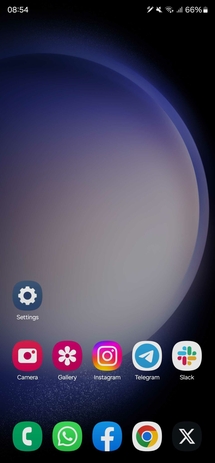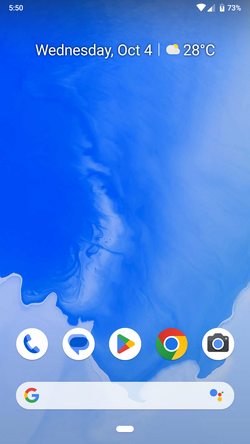
Android 13 is the thirteenth major release and the 20th version of Android, the mobile operating system developed by the Open Handset Alliance led by Google. It was released to the public and the Android Open Source Project (AOSP) on August 15, 2022. The first devices to ship with Android 13 were the Pixel 7 and 7 Pro.
Android is a mobile operating system based on a modified version of the Linux kernel and other open-source software, designed primarily for touchscreen mobile devices such as smartphones and tablets. Android is developed by a consortium of developers known as the Open Handset Alliance, though its most widely used version is primarily developed by Google. It was unveiled in November 2007, with the first commercial Android device, the HTC Dream, being launched in September 2008.
The version history of the Android mobile operating system began with the public release of its first beta on November 5, 2007. The first commercial version, Android 1.0, was released on September 23, 2008. The operating system is developed by Google on a yearly cycle since at least 2011. New major releases are announced at Google I/O along with its first public beta to supported Google Pixel devices. The stable version is then released later in the year.

Android Ice Cream Sandwich is the fourth major version of the Android mobile operating system developed by Google. Unveiled on October 19, 2011, Android 4.0 builds upon the significant changes made by the tablet-only release Android Honeycomb, in an effort to create a unified platform for both smartphones and tablets. The first phone with Android Ice Cream Sandwich was Samsung Galaxy Nexus.

Android Jelly Bean is the codename given to the tenth version of the Android mobile operating system developed by Google, spanning three major point releases. Among the devices that launched with Android 4.1 to 4.3 are the Nexus 7 (2012), Nexus 4, Nexus 10, Nexus 7 (2013), and Hyundai Play X.

Android KitKat is the codename for the eleventh Android mobile operating system, representing release version 4.4. Unveiled on September 3, 2013, KitKat focused primarily on optimizing the operating system for improved performance on entry-level devices with limited resources. The first phone with Android KitKat was the Nexus 5.

Windows Phone 8.1 is the third generation of Microsoft's Windows Phone mobile operating system, succeeding Windows Phone 8. Rolled out at Microsoft's Build Conference in San Francisco, California, on April 2, 2014, it was released in final form to Windows Phone developers on April 14, 2014 and reached general availability on August 4, 2014. All Windows Phones running Windows Phone 8 can be upgraded to Windows Phone 8.1, with release dependent on carrier rollout dates.

Wear OS is a version of Google's Android operating system designed for smartwatches and other wearables. By pairing with mobile phones running Android version 6.0 "Marshmallow" or newer, or iOS version 10.0 or newer with limited support from Google's pairing application, Wear OS integrates Google Assistant technology and mobile notifications into a smartwatch form factor. Wear OS is closed-source, in contrast to the free and open-source Android.

Android Lollipop is the fifth major version of the Android mobile operating system developed by Google and the 12th version of Android, spanning versions between 5.0 and 5.1.1. Unveiled on June 25, 2014 at the Google I/O 2014 conference, it became available through official over-the-air (OTA) updates on November 12, 2014, for select devices that run distributions of Android serviced by Google. Its source code was made available on November 3, 2014. The first phone with Android Lollipop was the Nexus 6.
Android Marshmallow is the sixth major version of the Android operating system developed by Google, being the successor to Android Lollipop. It was announced at Google I/O on May 28, 2015, and released the same day as a beta, before being officially released on September 29, 2015. It was succeeded by Android Nougat on August 22, 2016.

Android Nougat is the seventh major version and 14th original version of the Android operating system. First released as an alpha test version on March 9, 2016, it was officially released on August 22, 2016, with Nexus devices being the first to receive the update. The LG V20 was the first smartphone released with Nougat.

Daydream is a discontinued virtual reality (VR) platform which was developed by Google, primarily for use with a headset into which a smartphone is inserted. It is available for select phones running the Android mobile operating system that meet the platform's software and hardware requirements. Daydream was announced at the Google I/O developer conference in May 2016, and the first headset, the Daydream View, was released on November 10, 2016. To use the platform, users place their phone into the back of a headset, run Daydream-compatible mobile apps, and view content through the viewer's lenses.

Android Oreo is the eighth major release and the 15th version of the Android mobile operating system. It was initially unveiled as an alpha quality developer preview in March 2017 and later made available to the public, on August 21, 2017.

The OnePlus 5T is an Android-based smartphone produced, released and marketed by OnePlus. It was unveiled on 16 November 2017 via a live streamed press event which aired on YouTube. It went on sale on 21 November 2017. It is an incremental update to its predecessor, the OnePlus 5, which was unveiled only five months prior. Some notable changes that are featured, includes, a larger display and thinner bezels found on the device with the repositioning of the fingerprint scanner from the front to the rear panel. On 17 May 2018 the OnePlus 5T was succeeded by the OnePlus 6.

The Pixel 3 and Pixel 3 XL are a pair of Android smartphones designed, developed, and marketed by Google as part of the Google Pixel product line. They collectively serve as the successors to the Pixel 2 and Pixel 2 XL. They were officially announced on October 9, 2018 at the Made by Google event and released in the United States on October 18. On October 15, 2019, they were succeeded by the Pixel 4 and Pixel 4 XL.

One UI is a user interface (UI) developed by Samsung Electronics for its Android devices running Android 9 "Pie" and later. Succeeding Samsung Experience and TouchWiz, it is designed to make using larger smartphones easier and be more visually appealing. To provide more clarity, some elements of the UI are tweaked to match colors that are based on the color of the user's phone. It was announced at Samsung Developer Conference in 2018, and was unveiled in Galaxy Unpacked in February 2019 alongside the Galaxy S10 series, Galaxy Buds and the Galaxy Fold.

Android 10 is the tenth major release and the 17th version of the Android mobile operating system. It was first released as a developer preview on March 13, 2019, and was released publicly on September 3, 2019.

Android 11 is the eleventh major release and 18th version of Android, the mobile operating system developed by the Open Handset Alliance led by Google. It was released on September 8, 2020. The first phone launched in Europe with Android 11 was the Vivo X51 5G and after its full stable release, the first phone in the world which came with Android 11 was Google Pixel 5.

Android 12 is the twelfth major release and 19th version of Android, the mobile operating system developed by the Open Handset Alliance led by Google. The first beta was released on May 18, 2021. Android 12 was released publicly on October 4, 2021, through Android Open Source Project (AOSP) and was released to supported Google Pixel devices on October 19, 2021. As of April 2024, it is the oldest Android version still supported.
Android 14 is the fourteenth major release and the 21st version of Android, the mobile operating system developed by the Open Handset Alliance led by Google. It was released to the public and the Android Open Source Project (AOSP) on October 4, 2023. The first devices to ship with Android 14 are the Pixel 8 and Pixel 8 Pro.















